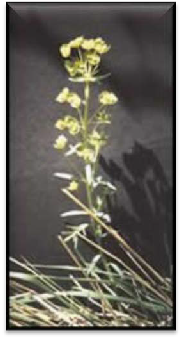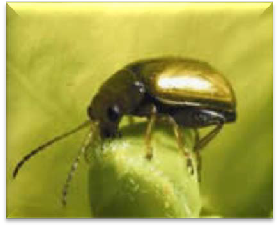Also Known as: wolf’s milk
Leafy Spurge is a Class B Weed. In regions where a Class B species is already abundant, control is decided at the local level, with containment as the primary goal.
Leafy Spurge (Euphorbia esula L.) is native to Eurasia and was accidentally introduced into the U.S. as a seed contaminant.  Leafy spurge was first recognized in the U.S. in the early 1800’s. Leafy spurge is a long-lived perennial exhibiting aggressive/competitive behavior towards other vegetation. Many stems may arise from a single rootstock and often appear clustered. Leafy spurge grows from 2 to 4 feet tall. Leaves are alternate, narrow, and long. In late May or early June, showy yellow bracts appear toward the tips of the short terminal branches, followed in a week or two by inconspicuous small green flowers without petals. Cup-like flowers are small, yellowish green and enclosed in slightly darker heart-shaped bracts that surround the stem. The female flowers of leafy spurge develop prior to the male, minimizing self pollination. The pollen and nectar are important food sources for insects, and
Leafy spurge was first recognized in the U.S. in the early 1800’s. Leafy spurge is a long-lived perennial exhibiting aggressive/competitive behavior towards other vegetation. Many stems may arise from a single rootstock and often appear clustered. Leafy spurge grows from 2 to 4 feet tall. Leaves are alternate, narrow, and long. In late May or early June, showy yellow bracts appear toward the tips of the short terminal branches, followed in a week or two by inconspicuous small green flowers without petals. Cup-like flowers are small, yellowish green and enclosed in slightly darker heart-shaped bracts that surround the stem. The female flowers of leafy spurge develop prior to the male, minimizing self pollination. The pollen and nectar are important food sources for insects, and  their avid feeding results in high rates of pollination. This deep rooted plant is adapted to a wide range of soil types and can out-compete vegetation in wet to extremely dry conditions. Leafy spurge spreads by rhizomatous roots and adventitious root buds and seeds. Seed production is high even when leafy spurge is grown in competition with perennial grasses. The seeds are contained within a three loculed capsule.
their avid feeding results in high rates of pollination. This deep rooted plant is adapted to a wide range of soil types and can out-compete vegetation in wet to extremely dry conditions. Leafy spurge spreads by rhizomatous roots and adventitious root buds and seeds. Seed production is high even when leafy spurge is grown in competition with perennial grasses. The seeds are contained within a three loculed capsule.
Each capsule develops at different rates. Once the capsule reaches maturity the other developing capsules put pressure on the ripe locule of that capsule and cause the seed to be expelled (thrown) up to 15 feet from the parent plant. Plants are able to maintain high root reserves through an extensive root system, ranging from a massive network of small lateral roots near the soil surface to deep, penetrating taproots that may reach depths of 21 ft. A unique characteristic of leafy spurge, which contributes to the plants ability to persist once it invades an area, are numerous stem buds which cover the thick very invasive roots. These stem buds can initiate growth when broken into small segments by tillage and are transported by birds, grazing animals, or in soil. The entire plant contains milky white latex that is mildly toxic to cattle and can cause blistering, skin irritation and blindness in humans. Special emphasis has been placed on this species by the Washington State Noxious Weed Control Board, and it is considered to be a top priority noxious weed throughout the state.
Economic Importance: Leafy spurge reduces the livestock carrying capacity of pasture and rangeland by 30 to 50 percent, causing an estimated $40-50 million loss per year in United States beef and hay production in addition to the millions of dollars spent for control. In Europe, natural biological controls keep leafy spurge from becoming a problem.
Distribution: The largest infestations of leafy spurge are located in the Union Flat Drainage, Risbeck area, near Oakesdale, along state highway south of Rosalia, and along the John Wayne Trail. In Asotin County, leafy spurge is scattered along the Snake and Grande Ronde Rivers.
Control Methods
Control Specifications: Control is mandatory in both Whitman and Asotin Counties.
Control Recommendations: An integrated control program combining two or more methods will provide a more successful and cost-effective long-term solution to the leafy spurge problem than a single method used alone.
Chemical Control: Herbicides are primarily used to treat leafy spurge. Control with herbicides is not always practical due to the high cost of treating large infestations and weeds can occur in environmentally sensitive areas, such as near water, where herbicide use is restricted. Imazapic can provide effective control in most habitats, especially scrubland and forest communities. Fall application is necessary for imazapic. Piclorams is effective for rangeland and pasture control and should be applied throughout the early growing stages of leafy spurge. Other herbicides (glyphosate) can be used but effectiveness is limited. Selected herbicides in combination with competitive vegetation and biological organisms can be effective for control.
More information can be found in the PNW Weed Management Handbook
Use pesticides with care. Apply them only to plants, animals, or sites listed on the label. When mixing and applying pesticides, follow all label precautions to protect yourself and others around you. It is a violation of the law to disregard label directions. Store pesticides in their original containers and keep them out of the reach of children, pets, and livestock.
Biological Control: Biological methods can provide good but not complete leafy spurge control. Sheep and goats provide an alternative to herbicides for controlling leafy spurge and have been found to be an effective biological control agent in pasture and rangeland. Grazing alone will not eradicate leafy spurge but will reduce the infestation and spread of the weed. There are many insect biological control agents for leafy spurge. The most effective insect biological control agents are Aphthona nigriscutis, Aphthona lacertosa, Aphthona cyparissiae, Aphthona czwalinae and Aphthona flava, all of which are flea beetles. Flea beetle populations take three to five years to become well established and the insects should not be collected or moved during this time. While the insects are establishing do not spray insecticides within a quarter-mile of the site, cultivate or burn the release site. Landowners should prevent expansion of the leafy spurge infestation through monitoring and the use of other practices (herbicides, grazing, herbicides in combination with revegetation) at the perimeters of the infested area. Herbicides should not be applied directly over the insects in early summer since this would remove the food source for adult beetles. Once established the insects should be redistributed by the manager because natural flea beetle movement to other infested areas is extremely slow.
Aphthonea nigriscutis
Aphthonea czwalinea
Photo credits included in PDF

